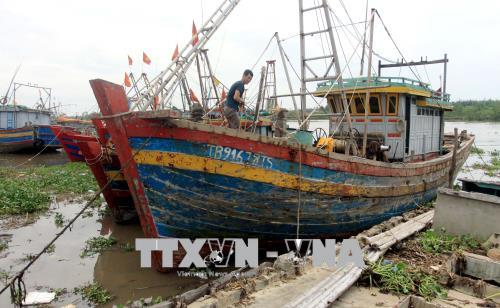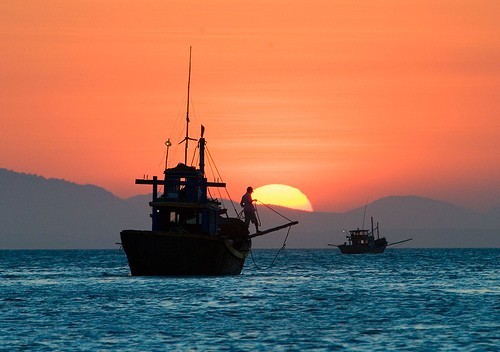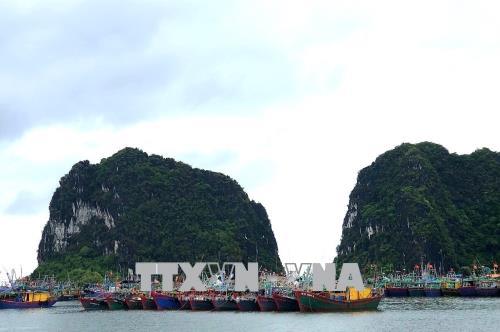 Storm Mulan heads toward northern coast
Storm Mulan heads toward northern coast
Home > Standpoints
Ruling of the century and landmark in the East Sea (part 1)
By VNA 12/19/2017 10:12 |

For the first time in its history, China - the “world center” - was sued by a small country on a maritime dispute__Photo: Internet
Nguyen Hong Thao
Professor Associate in Law
On July 12, 2016, the Arbitral Tribunal (the Tribunal) constituted under Annex VII to the 1982 United Nations Convention on the Law of the Sea (the Convention) issued the Award on the merits of the legal case filed by the Republic of the Philippines (the Philippines) against the People’s Republic of China (China) in the South China Sea (East Sea)(1).
For the first time in its history, China - the “world center” - was sued by a small country on a maritime dispute. It is the first time the Tribunal has clear and direct answers and explanations in detail as to what is the right implementation of Article 121.3 of the Convention and thereby contributes to the development of the law of the sea. The verdict has not only affected the main stakeholders of the case but also many other countries in the region and beyond. After 17 years of bilateral negotiations and three years of lawsuits and procedures for trial, the verdict given is considered beneficial to the Philippines. The Tribunal ruled that the verdict is final and binding for all stakeholders, even for the absent party. China’s refusal to participate did not affect the Tribunal’s judgment. The ruling has played an important role in politico-economic and security affairs of the countries in the East Sea, in the ASEAN’s internal solidarity, the Sino-US competition and foreign policies of the countries having interests in the East Sea. The ruling is also a test of the credibility of international law and of the respect and goodwill of the parties in its implementation. The unintended effects of the ruling will also have an impact on many generations.
The 501-page ruling affirmed the Tribunal has the competence to fully review the Philippines submissions and gave answer to each question.
Jurisdiction
In addition to the arguments announced in the award on jurisdiction and admissibility dated October 29, 2015, the Tribunal continues considering the exceptions that Chinese declaration in 2006 to Article 298 of the Convention may discourage competence. The two new exceptions have been rejected. The Tribunal pointed out that the exception in Article 298 would apply only if the Philippines’ submissions concerned law enforcement activities in China’s exclusive economic zone. However, because the Philippines’ submissions related to the events taking place in the Philippines’ own exclusive economic zone or in the territorial waters, should Article 298 not hinder the jurisdiction of the Tribunal. The second exception is that military activities do not fall under the jurisdiction of the Tribunal. Deriving from the fact that China had repeatedly emphasized the non-military nature of its land reclamation activities and had stated at the highest level that China will not militarize its presence in the Spratlys, the Tribunal decided not to consider those activities to be military in nature. This argument allows the Tribunal to eliminate the exception of Article 298 related to military activities. By that conclusion, the Tribunal has confirmed the value of unilateral acts of States, especially through the statements of high-ranking leaders, thus creating a subsidiary source of international law which is of binding nature. Based on the analysis of the two awards on jurisdiction and merits, the Tribunal declared it has full competence to consider the merits of the submissions from the Philippines.
The “so-called” nine-dash line
The Tribunal has used the method of elimination to identify the most common between the Philippines’ submissions and China’s claims over which the Tribunal has jurisdiction. The Tribunal affirmed not to consider the issue of sovereignty over maritime features within the nine-dash line.
The Tribunal has carefully reviewed the historic title concept. The historic title can create the sovereignty and the Claimant State must give sufficient evidences. This concept is referred to in Article 15 of the Convention relating to delimitation of the territorial sea. Considering the historic title can be eliminated by the Chinese declaration in 2006. However, China has never proven the legal nature and scope of his historic title that entails. Chinese declarations used to note the sovereignty over the islands and adjacent waters, and also demand “the relevant rights formed in the long historical course”. The vagueness and ambiguity in the statements made by China do not prove their historic title.
According to the Tribunal, China’s claim to historic rights to resources within the nine-dash line is inconsistent with the detailed allocation of rights and maritime zones in the Convention. If China had historic rights to the resources in the waters of the East Sea, such rights were extinguished by the entry into force of the Convention to the extent those maritime zones within the scope of the nine-dash line were incompatible with the Convention’s system of maritime zones. On the other hand, before the entry into force of the Convention and the exclusive economic zone becomes a customary law institution, beyond the 12 nautical miles territorial waters are the high seas. All fishing activities of fishermen from China and other countries in those areas had been the exercise of the right of freedom of fishing, not historic. So, maritime and fishing activities outside territorial seas cannot form the basis for the formation of historic rights.
The Tribunal noted although there is evidence that Chinese navigators and their fishermen, as well as those from other countries, had historically made use of these islands in the East Sea, it’s not true that China has exercised historically exclusive control over the waters or resources or prevented other States from exploiting the resources in the East Sea. So, with submissions Nos. 1 and 2 of the Philippines concerning the legal validity of the nine-dash line, the Tribunal declared that “as between the Philippines and China, there was no legal basis for China to claim historic rights to the resources, in excess of the rights provided for by the Convention within the sea areas falling within the nine-dash line.” By this statement, the Tribunal has dismissed two of three aspects that Chinese scholars often used to justify the dotted line: traditional fishing rights and historic waters claims. There remains only the aspect of claiming sovereignty over maritime features falling within the scope of the nine-dash line, which the Tribunal has no jurisdiction.
The legal status of maritime features in the Spratlys and Scarborough Shoal
Philippines specifically mentioned only seven features in their submissions. The Tribunal agrees with the Philippines that Johnson South Reef, Cuarteron Reef, Fiery Cross Reef and Scarborough are rocks; Subi Reef, Hughes Reef, Mischief Reef and Second Thomas Shoal are the low-tide elevations in natural conditions but it does not agree with the Philippines on the case of Gaven and Mekennam reefs and concluded that both features are high-tide. The Tribunal made a clear interpretation of Article 121.3 and concluded that the entitlement of a feature depends on (i) the objective capacity of the feature; (ii) its natural conditions, to sustain either (iii) a stable community of people, or (iv) economic activity that is not dependent on outside resources or purely extractive in nature. The modern presence of official personnel on many of the features does not establish their capacity in their natural condition, or the land reclamation and infrastructure construction do not change the original legal status of feature, etc. From this argument and in applying the analogue principles, the Tribunal concluded that all of the high-tide features in the Spratly Islands (even the largest island of Itu Aba) are legally “rocks” that do not generate economic exclusive zone or continental shelf. This is an important decision not only for the South China Sea dispute but also for the East China Sea, Diaoyu islands dispute, Tokto islands, the Ryukyu archipelago and other rocky islands dispute applying Article 121.3 of the Convention. It confirms the Tribunal role in minimizing disputes and seeking solutions to peace and international stability. However, China may reject that decision in assuming that the Tribunal exceeded its competence and settle out the submissions of the Philippines.
The Tribunal also concluded that the Convention does not provide for a group of islands like the Spratlys to generate maritime zones collectively as a unit. It prevents any future attempts to establish straight baselines for the Spratlys as a single entity like China did with the Paracels in 1996.
(To be continued)
(1) PCA Case No. 2013-19: The
Photo
 Storm Mulan heads toward northern coast
Storm Mulan heads toward northern coast
 Storm Mulan heads toward northern coast
Storm Mulan heads toward northern coast
 Storm Mulan heads toward northern coast
Storm Mulan heads toward northern coast
 Storm Mulan heads toward northern coast
Storm Mulan heads toward northern coast